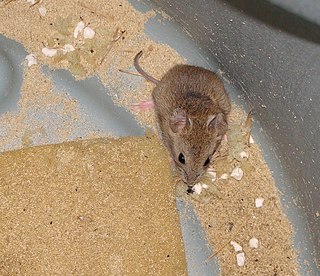The large vesper mouse is a South American rodent species of the family Cricetidae.

The small vesper mouse is a rodent species from South America. It is found in Argentina, Bolivia, Brazil, Paraguay and Uruguay. It is one of the hosts of hantavirus, causing hantavirus pulmonary syndrome
The delicate vesper mouse is a South American rodent species of the family Cricetidae. It is found in Argentina, Bolivia and Brazil. Its karyotype has 2n = 66 and FN = 66.
The Tocantins vesper mouse is a South American rodent species of the family Cricetidae. It is found in Brazil. Its karyotype has 2n = 46 and FNa = 66.
Akodon boliviensis, also known as the Bolivian grass mouse or Bolivian akodont, is a species of rodent in the family Cricetidae. It is found in the Andes from southeastern Peru through Bolivia into northwestern Argentina.
The Bolivian vesper mouse is a species of rodent in the family Cricetidae. It is found in Argentina, Bolivia and perhaps Peru.
The crafty vesper mouse is a species of rodent in the family Cricetidae. It is found in Argentina and Paraguay.

Hummelinck's vesper mouse is a species of rodent in the family Cricetidae. It is found in Aruba, Brazil, Colombia, the Netherlands Antilles, and Venezuela.
The Andean vesper mouse is a species of rodent in the family Cricetidae. It is found in Argentina, Bolivia, Chile, and Peru.

The drylands vesper mouse is a species of rodent in the family Cricetidae. It is found in Argentina, Bolivia and Paraguay.
The Andean gerbil mouse or Altiplano laucha is a species of rodent in the family Cricetidae. It is found in Argentina, Bolivia, Chile, and Peru.
Melanomys zunigae, also known as Zuniga's melanomys or Zuniga's dark rice rat, is a species of rodent in the genus Melanomys of family Cricetidae. Known only from a small region of coastal Peru, it is listed as "critically endangered" by the IUCN and may even be extinct.
Oecomys phaeotis, also known as the dusky arboreal rice rat or dusky oecomys, is a species of rodent in the genus Oecomys of family Cricetidae. It is found on the eastern slopes of the Andes of Peru, at 1500 to 2000 m altitude.
Oligoryzomys arenalis, also known as the sandy colilargo or sandy pygmy rice rat, is a species of rodent in the genus Oligoryzomys of family Cricetidae. It is found in the Andes of Peru at 400 to 2850 m altitude, but may include more than one species.
The Andean leaf-eared mouse is a species of rodent in the family Cricetidae. It is found in Ecuador and Peru.
The master leaf-eared mouse is a species of rodent in the family Cricetidae. It is found in Chile and Peru.
Daphne's Oldfield mouse is a species of rodent in the family Cricetidae. It is found in Bolivia and Peru.
The caatinga vesper mouse is a rodent species in the family Cricetidae from South America. It is endemic to eastern Brazil, where it is found in open savanna (cerrado) and thorny scrub (caatinga) habitats. Its karyotype has 2n = 66 and FN = 68. It was formerly synonymized with C. callosus, but the latter has 2n = 50 and FN = 66. Karyologic analysis of C. expulsus has shown that the X chromosome is large and submetacentric while the Y chromosome is either acrocentric or submetacentric. Predators include the barn owl. Sexual dimorphism in shape and size occurs; the former is present mainly before the age of 20 days. Males are smaller before age 50 days and larger thereafter, which becomes less prominent after 200 days.
The Córdoba vesper mouse or Córdoba laucha is a South American rodent species of the family Cricetidae. It is endemic to the area of Córdoba Province, central Argentina, where it is found in the espinal.
The fecund vesper mouse is a species of rodent in the family Cricetidae. It is known only from Bolivia, where it is found in the yungas and Tucumano boliviano forest ecoregions at elevations from 600 to 2700 m. It is regarded by some authorities as conspecific with C. boliviae, and by some as conspecific with C. venustus, despite having a karyotype with 2n = 54 while C. venustus generally has a karyotype with 2n = 56.


